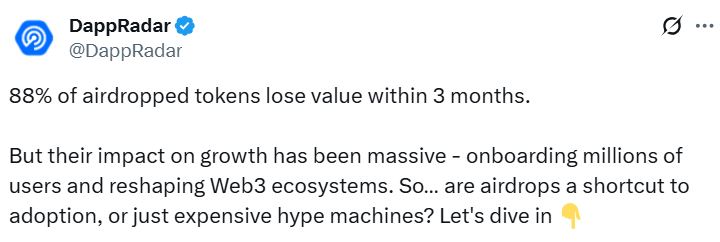
Airdrops constitute a prevalent method for new cryptocurrency projects to distribute tokens, yet approximately 88% of these tokens depreciate within just three months following their release, as highlighted by a study conducted over the past seven years.
A report from Sept. 18 by DappRadar analyst Sara Gherghelas examined data indicating that since 2017, over $20 billion has been allocated to airdrops, revealing that a staggering 88% of airdropped tokens subsequently lost value within mere months, illustrating the disconnect between fleeting hype and enduring viability.
In discussions with Cointelegraph, Robert Hoogendoorn, DappRadar’s head of content, emphasized that the method of token distribution plays a crucial role in the achievements of an airdrop. Projects aim to place their tokens into the hands of dedicated holders.
 Source: DappRadar
Source: DappRadar
“Some of the more successful airdrops utilized phased distribution or targeted strategies to mitigate community sell-off. However, there is no universal formula for success; it fundamentally depends on distribution, product-market alignment, and the utility of the token,” Hoogendoorn noted.
“Moreover, general market trends significantly influence airdrop valuations as well. A successful airdrop keeps the community engaged with the product even post-token deployment.”
The origin of crypto airdrops dates back to 2014, when Auroracoin executed its initial distribution in an effort to provide an alternative to Bitcoin for Iceland.
Selecting Holders with Care
Over the decade since Auroracoin’s debut, Hoogendoorn remarked that airdrops have become more prevalent in bull markets, evolving through the inclusion of on-chain involvement, social media campaigns, and liquidity provision strategies.
 Source: Cointelegraph
Source: Cointelegraph
Nevertheless, Hoogendoorn cautions that project developers must meticulously assess a user’s on-chain behaviors, trading patterns, and even their reputation on social media to circumvent the pitfalls of airdrop hunting and farming.
“We are witnessing a growing trend where airdrop distributions are linked to a social media reputation, integrating social engagement in the process. Furthermore, some initiatives are employing engagement and reward platforms to share their airdrop allocations effectively,” he explained.
The Fate of Airdrops from Unstable Projects
Jackson Denka, CEO of Azura, a DeFi platform supported by the Winklevoss twins, expressed to Cointelegraph that many airdrop tokens lose value due to their ties to flawed protocols that fail to garner genuine adoption and produce revenue.
“Financial engineering, incentivization, or user bribes cannot alter the fundamental fact that some assets are a superior investment than others,” he stated.
“Tokens from well-structured projects tend to appreciate in value over a sufficient timeline, irrespective of flaws in their distribution mechanisms.”
Hyperliquid was praised for executing an exemplary airdrop by intentionally excluding venture capitalists while fervently promoting community involvement during its launch in November 2024.
Denka predicts that in the long term, airdrops will recede as more initial coin offerings (ICOs) emerge, enabling investors to pay for tokens before their market debut akin to public offerings but based on cryptocurrency assets.
“No financial market globally offers free stakes in their ventures to clientele; Uber, Robinhood, and Facebook didn’t follow this approach,” he stated.
“The airdrop phenomenon will likely be regarded retrospectively as a fleeting episode in the broader narrative of cryptocurrency, though they will continue to exist.”
Addressing Liquidity Issues
Kanny Lee, CEO of SecondSwap, a marketplace for trading locked tokens, opined that airdrops suffer depreciation due to the excessive liquidity introduced too hastily, inundating the market.
Recent instances of successful airdrops illustrated that rewarding users for sustained activity fosters liquidity retention despite initial fluctuations, complemented by a structured unlock timeline that facilitates gradual market entry.
Lee added, “Both strategies reinforce the understanding that value endures longer when user involvement is prioritized, and liquidity is developed gradually.”
Looking ahead, Lee anticipates that incentive trends aimed at rewarding users for maintaining token holdings will gain traction as standard practices.
“The principal objective of any airdrop framework should be sustainable liquidity; it matters less how many wallets hold tokens and more about how long those tokens remain dynamic within the market,** he remarked.
“Programs that encourage ongoing involvement or staggered supply releases can diminish the severe downturns following mass distributions.”



